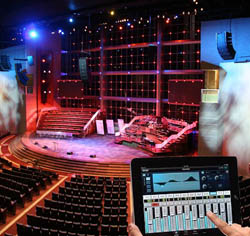Do you think iPad remote mixing is simply a fad? Or do you feel you finally have a tool that will benefit your audio production?
I’ll go as far as saying it’s something you’ll never want to give up once you try it. There are several ways remote mixing can be beneficial…
1) Mixing Monitors On The Stage
Remote mixing apps can give you the ability to mix your aux sends to your different monitors.
In this case, you can stand on the stage and either set an approximate mix for each musician before they get there or stand with them while you set the mix.
The latter can save you time in going back and forth with hand signals or other more tedious methods. In some cases, musicians can use their own iPad’s to control their monitor mix on the fly.
2. Mixing In The Sanctuary
Part of setting your house mix is walking the room and listening to how it sounds in different parts of the sanctuary. Then, going back to the mixing board and making those changes…and rechecking after that.
Remote mixing enables you to walk the room and make those changes from where you are standing. And if you’ve never “walked the room,” it’s a great reason to start.
3. Sitting With The Family
If you’ve been running sound long enough, you might find yourself in a situation like I’ve faced. It’s a holiday service and the service schedule is simple; a guitar, a singer, and the pastor’s mic. You want to sit with your family during the service because it’s the right thing to do during such a holiday – to be together with your family.
However, all the other sound techs have left town and it’s up to you. This would be a great time for remote mixing.
There are a lot of variables at play as to whether or not such remote mixing should be done but I do want to mention it as a use of the technology.
4. Mixing From The Best Position
Portable setups are where I see this most helpful. It’s usually in a large ballroom or other similar arena where the mixing board is required to be behind the stage or out of line from the house loudspeakers.
Having mixed in similar scenarios, remote mixing from the best location would have save me a lot of headaches.
Conclusion
Remote mixing gives you the ability to change your mix (even monitor mixes) immediately. While I’m all for getting some exercise, I welcome a few less trips to and from the sound booth.
Ready to learn and laugh? Chris Huff writes about the world of church audio at Behind The Mixer. He covers everything from audio fundamentals to dealing with musicians, and can even tell you the signs the sound guy is having a mental breakdown.





















